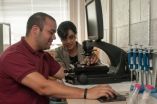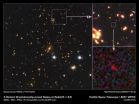(Press-News.org) (Santa Barbara, Calif.) –– A multi-university team has employed a high-powered laser based at UC Santa Barbara to dramatically improve one of the tools scientists use to study the world at the atomic level. The team used their amped-up electron paramagnetic resonance (EPR) spectrometer to study the electron spin of free radicals and nitrogen atoms trapped inside a diamond.
The improvement will pull back the veil that shrouds the molecular world, allowing scientists to study tiny molecules at a high resolution.
The team, which includes researchers from UCSB, University of Southern California (USC), and Florida State University, published its findings this week in Nature.
"We developed the world's first free-electron laser-powered EPR spectrometer," said Susumu Takahashi, assistant professor of chemistry at the USC Dornsife College of Letters, Arts and Sciences, and lead author of the Nature paper. "This ultra high-frequency, high-power EPR system gives us extremely good time resolution. For example, it enables us to film biological molecules in motion."
By using a high-powered laser, the researchers were able to significantly enhance EPR spectroscopy, which uses electromagnetic radiation and magnetic fields to excite electrons. These excited electrons emit electromagnetic radiation that reveals details about the structure of the targeted molecules.
EPR spectroscopy has existed for decades. Its limiting factor is the electromagnetic radiation source used to excite the electrons –– it becomes more powerful at high magnetic fields and frequencies, and, when targeted, electrons are excited with pulses of power as opposed to continuous waves.
Until now, scientists performed pulsed EPR spectroscopy with a few tens of GHz of electromagnetic radiation. Using UCSB's free electron laser (FEL), which emits a pulsed beam of electromagnetic radiation, the team was able to use 240 GHz of electromagnetic radiation to power an EPR spectrometer.
"Each electron can be thought of as a tiny magnet that senses the magnetic fields caused by atoms in its nano-neighborhood," said Mark Sherwin, professor of physics and director of the Institute for Terahertz Science and Technology at UCSB. "With FEL-powered EPR, we have shattered the electromagnetic bottleneck that EPR has faced, enabling electrons to report on faster motions occurring over longer distances than ever before. We look forward to breakthrough science that will lay foundations for discoveries like new drugs and more efficient plastic solar cells."
INFORMATION:
The research was funded by the National Science Foundation and the W. M. Keck Foundation.
Using a laser to 'see' the smallest world
Scientists employ a powerful UCSB laser to breathe new life into an old technology for studying atomic-level structures
2012-09-20
ELSE PRESS RELEASES FROM THIS DATE:
UGA researchers boost efficacy of drugs by using nanoparticles to target 'powerhouse of cells'
2012-09-20
Athens, Ga. - Nanoparticles have shown great promise in the targeted delivery of drugs to cells, but researchers at the University of Georgia have refined the drug delivery process further by using nanoparticles to deliver drugs to a specific organelle within cells.
By targeting mitochondria, often called "the powerhouse of cells," the researchers increased the effectiveness of mitochondria-acting therapeutics used to treat cancer, Alzheimer's disease and obesity in studies conducted with cultured cells.
"The mitochondrion is a complex organelle that is very difficult ...
Johns Hopkins astrophysicist spies ultra-distant galaxy amidst cosmic 'dark ages'
2012-09-20
With the combined power of NASA's Spitzer and Hubble space telescopes as well as a cosmic magnification effect, a team of astronomers led by Wei Zheng of The Johns Hopkins University has spotted what could be the most distant galaxy ever detected.
Light from the young galaxy captured by the orbiting observatories shone forth when the 13.7-billion-year-old universe was just 500 million years old.
The far-off galaxy existed within an important era when the universe began to transit from the so-called "Dark Ages." During this period, the universe went from a dark, starless ...
The 'slippery slope to slime': Overgrown algae causing coral reef declines
2012-09-20
CORVALLIS, Ore. – Researchers at Oregon State University for the first time have confirmed some of the mechanisms by which overfishing and nitrate pollution can help destroy coral reefs – it appears they allow an overgrowth of algae that can bring with it unwanted pathogens, choke off oxygen and disrupt helpful bacteria.
These "macroalgae," or large algal species, are big enough to essentially smother corals. They can get out of control when sewage increases nitrate levels, feeds the algae, and some of the large fish that are most effective at reducing the algal buildup ...
The key to cooperation? Think fast
2012-09-20
It's an age old question: Why do we do good? What makes people sometimes willing to put "We" ahead of "Me?" Perhaps our first impulse is to be selfish, and cooperation is all about reining in greed. Or maybe cooperation happens spontaneously, and too much thinking gets in the way.
Harvard scientists are getting closer to an answer, showing that people's first response is to cooperate and that stopping to think encourages selfishness.
David Rand, a Post-Doctoral Fellow in Psychology, Joshua Greene, the John and Ruth Hazel Associate Professor of the Social Sciences ...
New cranial neural crest cell line developed
2012-09-20
New Rochelle, NY, September 19, 2012-- Researchers have successfully developed a stable population of neural crest cells derived from mice that can be grown in large quantities in the laboratory and that demonstrates the potential to develop into many different cell types needed throughout the body. This powerful new research tool for understanding stem cell biology and human development and disease is described in an article published in Stem Cells and Development, a peer-reviewed journal from Mary Ann Liebert, Inc., publishers. The article is available free on the Stem ...
GEN reports on growth of biobanking operations
2012-09-20
New Rochelle, NY, September 19, 2012— Many biotech observers maintain that the future of healthcare will largely be based on the field of personalized medicine, reports Genetic Engineering & Biotechnology News (GEN) (http://genengnews.com). Although drug discovery efforts require access to increasingly larger arrays of biosamples, demand is exceeding supply, fueling the growth of the biobanking market, according to a recent issue of GEN (http://genengnews.com/gen-articles/biobanking-confronts-growing-pains/4481).
"Personalized medicine is all about tailoring specific ...
Study: DNA barcoding can ID natural health products
2012-09-20
DNA barcoding developed by University of Guelph researchers has proven up to 88 per cent effective in authenticating natural health products, according to a new U of G study.
The study appears in the latest issue of Food Research International.
It's a crucial finding because the health product industry is under-regulated worldwide and mislabelling poses economic, health, legal and environmental implications, says study author Mehrdad Hajibabaei.
"Currently there is no other broadly applicable tool that can identify the species used in both animal and plant natural ...
ASGE initiative addresses endoscopy simulators for training and skill assessment
2012-09-20
OAK BROOK, Ill. – September 19, 2012 – The American Society for Gastrointestinal Endoscopy's (ASGE) Preservation and Incorporation of Valuable Endoscopic Innovations (PIVI) initiative addresses the use of endoscopy simulators for training and assessing skills in an article appearing in the September issue of GIE: Gastrointestinal Endoscopy, ASGE's monthly peer-reviewed scientific journal. This PIVI is one in a series of statements defining the diagnostic or therapeutic threshold that must be met for a technique or device to become considered appropriate for incorporation ...
Split-dose preparation for colonoscopy increases precancerous polyp detection rates
2012-09-20
OAK BROOK, Ill. – September 19, 2012 – A new study from researchers at the Mayo Clinic Arizona showed that system-wide implementation of a split-dose preparation as the primary choice for colonoscopy significantly improved both polyp detection rates and adenoma (precancerous polyp) detection rates, overall quality of the preparation, and colonoscopy completion rates. The study appears in the September issue of GIE: Gastrointestinal Endoscopy, the monthly peer-reviewed scientific journal of the American Society for Gastrointestinal Endoscopy (ASGE).
Colorectal cancer develops ...
Researchers identify possible key to slow progression toward AIDS
2012-09-20
One of the big mysteries of AIDS is why some HIV-positive people take more than a decade to progress to full-blown AIDS, if they progress at all.
Although the average time between HIV infection and AIDS in the absence of antiretroviral treatment is about 10 years, some individuals succumb within two years, while so-called slow progressors can stay healthy for 20 years or longer.
Researchers already know that many slow progressors carry a gene called HLA-B*57 (B57), an immune gene variant that is found in less than 5 percent of the general population but in 40 to ...
LAST 30 PRESS RELEASES:
Injectable breast ‘implant’ offers alternative to traditional surgeries
Neuroscientists devise formulas to measure multilingualism
New prostate cancer trial seeks to reduce toxicity without sacrificing efficacy
Geometry shapes life
A CRISPR screen reveals many previously unrecognized genes required for brain development and a new neurodevelopmental disorder
Hot flush treatment has anti-breast cancer activity, study finds
Securing AI systems against growing cybersecurity threats
Longest observation of an active solar region
Why nail-biting, procrastination and other self-sabotaging behaviors are rooted in survival instincts
Regional variations in mechanical properties of porcine leptomeninges
Artificial empathy in therapy and healthcare: advancements in interpersonal interaction technologies
Why some brains switch gears more efficiently than others
UVA’s Jundong Li wins ICDM’S 2025 Tao Li Award for data mining, machine learning
UVA’s low-power, high-performance computer power player Mircea Stan earns National Academy of Inventors fellowship
Not playing by the rules: USU researcher explores filamentous algae dynamics in rivers
Do our body clocks influence our risk of dementia?
Anthropologists offer new evidence of bipedalism in long-debated fossil discovery
Safer receipt paper from wood
Dosage-sensitive genes suggest no whole-genome duplications in ancestral angiosperm
First ancient human herpesvirus genomes document their deep history with humans
Why Some Bacteria Survive Antibiotics and How to Stop Them - New study reveals that bacteria can survive antibiotic treatment through two fundamentally different “shutdown modes”
UCLA study links scar healing to dangerous placenta condition
CHANGE-seq-BE finds off-target changes in the genome from base editors
The Journal of Nuclear Medicine Ahead-of-Print Tip Sheet: January 2, 2026
Delayed or absent first dose of measles, mumps, and rubella vaccination
Trends in US preterm birth rates by household income and race and ethnicity
Study identifies potential biomarker linked to progression and brain inflammation in multiple sclerosis
Many mothers in Norway do not show up for postnatal check-ups
Researchers want to find out why quick clay is so unstable
Superradiant spins show teamwork at the quantum scale
[Press-News.org] Using a laser to 'see' the smallest worldScientists employ a powerful UCSB laser to breathe new life into an old technology for studying atomic-level structures




